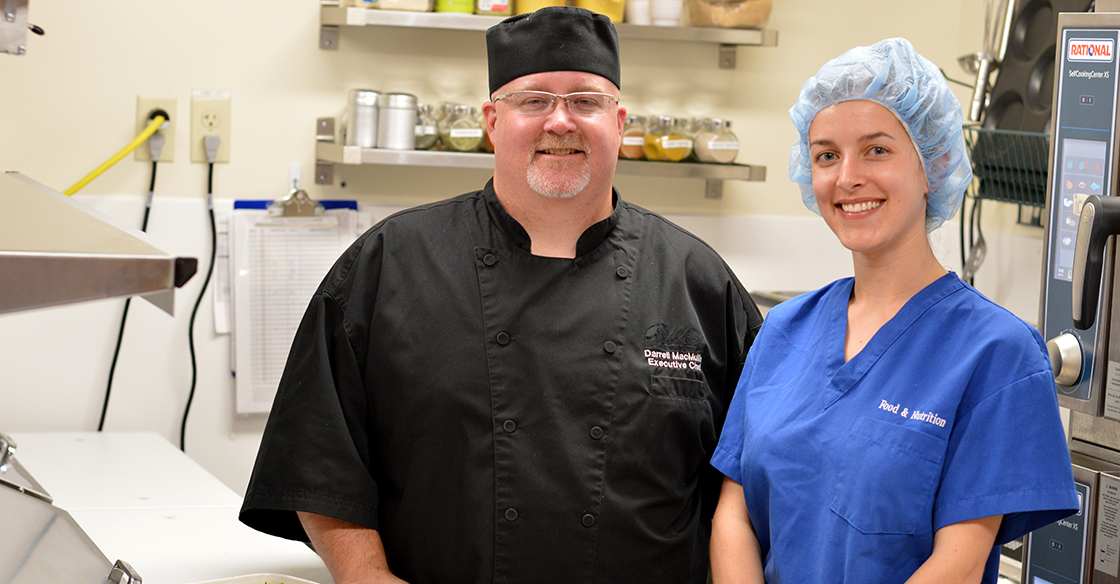
Changes are coming to the QEII Health Sciences Centre’s Halifax Infirmary site that will give patients the ability to order restaurant-quality meals and have them delivered within the hour.
In the past, patients have selected their meals two days in advance. Food is prepared in a large, centralized kitchen with certain items quick-chilled or flash-frozen. The food is plated cold, one meal ahead, transported to individual sites, reheated and then taken to the patients.
As Marilyn Cipak, the director of nutrition and food services for the Nova Scotia Health Authority (NSHA) explains, this process can often lead to complications.
“Patients might not remember what they ordered or don’t feel like eating when they order and they might not get much food, even when they’re starting to feel more like eating,” she says. “Or perhaps they feel like eating two days prior when they ordered, but don’t feel like eating when it arrives. Patients might also be having tests done when their food is delivered and it’s cold when they get back.”
According to Brenda MacDonald, senior director for nutrition and food services, this can result in widespread food wastage and even malnutrition.
“A national survey by the Canadian Malnutrition Task Force in 2014 revealed that 45 per cent of patients who come into hospitals are malnourished, and 47 per cent are malnourished when they go home. We need to fix this,” she says.
This led to an audit at the QEII’s Halifax Infirmary site.
“We were throwing almost 35 per cent of our food out, meaning that patients were not eating,” Brenda says. “That’s why we’re so excited to implement this room service model.”
A room service model successfully instituted at smaller sites, looked like a promising alternative.
“Our goal is to encourage patients to eat more and that’s what has happened in our hospitals across Nova Scotia who switched to room service. When patients can order what they want, when they want it (during operational hours), they eat more. The food waste across the province has reduced greatly in many hospitals to less than 10 per cent,” Brenda says.
Culinary and chef manager for NSHA, Darrell MacMullin, was recruited to ensure that nutritious, visually appealing and flavourful food could be made to order on a much larger scale.
“We haven’t changed a lot of products,” Darrell indicates. “We’re cooking food once and then serving it.”
Aiding in this transition are some remarkable advancements in the kitchen.
“The ovens we’re using now are giving us quick, restaurant-quality results.”
In this new process, patients are supplied with a varied menu filled with healthy options. Attendants, like Kirsten Hogg, take the patient’s order using a tablet, noting any relevant dietary exceptions. The order is then printed in the unit’s kitchen, the meal is prepared and then delivered within 40 minutes or less.
This also gives staff the ability to closely monitor the patient’s eating habits.
“We need to value food and nutrition for healing and recovery.”
-Brenda MacDonald
“Normally, our food production team is far away from the patient so being up on the unit has created a real sense of excitement for them,” Marilyn says. “We don’t want to be giving patients food that they don’t want to consume, so given our close proximity to the patients, we expect a quick turnaround time, making it easier to respond to their needs.”
As food waste is curtailed, the resulting cost savings can be re-invested back into the program.
“We can buy local, healthier, fresher food because we’re not throwing it out,” Brenda explains.
As an industry veteran, Darrell also knows the value of consolidation.
“Eventually, all sites within the QEII and across the province will be using similar recipes and products so we can negotiate better prices,” Darrell says.
In 2019, this new model will be rolled out unit-by-unit at the QEII’s Halifax Infirmary site, with other sites added in the future. From Marilyn’s perspective, a team approach will be instrumental to its success.
“It’s not just nutrition and food services,” Marilyn says. “We’ve got great support from our clinical teams including our dietitians, nursing and others. The buy-in from senior leadership has really supported our team as well.”
Darrell believes the program will have a host of additional benefits.
“If patients are eating and enjoying their food, it’s going to change the attitude for the staff as well.”
For Brenda, treating ‘food as medicine,’ is key.
“We need to value food and nutrition for healing and recovery,” she says. “For example, research tells us that patients recover quicker and can go home faster if they are eating well while in the hospital. We truly believe that food is medicine and working with the entire healthcare team, together we can change the perception of hospital food and build a culture of nutrition.”